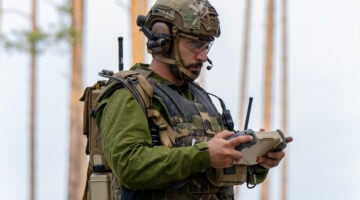
WASHINGTON — The Defense Department is sending F-35 fighter aircraft and a Navy destroyer, in addition to F-16s, to US Central Command in the Middle East, in an effort to deter further Iranian actions at a critical waterway in the Gulf.
“In response to a number of recent alarming events in the Strait of Hormuz, the secretary of defense has ordered the deployment of the of the destroyer USS Thomas Hudner, F-35 fighters and F-16 fighters to the US Central Command [CENTCOM] area of responsibility to defend US interests and safeguard freedom of navigation in the region,” Deputy Pentagon Press Secretary Sabrina Singh announced today during a Pentagon briefing.
Singh did not disclose the number of additional aircraft tapped for the expanded mission, when they, along with the destroyer, will arrive in the region, nor how long they will remain there.
“The department regularly makes postural adjustments based on current and future operational needs,” Singh later added. “We’ve seen Iran continue to harass vessels in the Strait of Hormuz, and so the secretary and [the] CENTCOM commander felt it was appropriate to move more assets into the region to help bolster what they needed there.”
Earlier this month the US Navy said it would increase patrols in the region after the service said it thwarted Iran from seizing two commercial tankers.
“We call upon Iran to immediately cease these destabilizing actions that threaten the free flow of commerce through this strategic waterway, of which the world depends on for more than one-fifth of the world’s oil supply,” Singh said.
While Singh’s announcement today of F-35s and a destroyer to the region is new, on July 14 a senior US defense official disclosed plans to beef up the military’s presence in the region with a fresh deployment of F-16s. That official explained that Pentagon leaders are trying to strike the right balance between deploying maritime and air components to the region, in part to provide more surveillance and identify which vessels might be at risk.
“It appears to me that we have stopped some attempted seizures,” the official said. “I think our presence is very visible. It’s serving deterrent effects. We’ll see if it’s deterrent enough over the coming days.”
At that time, the official would not comment on specific force movements when asked whether F-35s were also being considered for deployment to the region, though the official noted that the jet would “absolutely” be a useful capability that can operate in contested environments, unlike the sluggish A-10s that are currently flying deterrence missions.
This is not the first time in recent weeks the department has announced it is sending additional assets into CENTCOM’s area of responsibility. Just last month, for example, it said more F-22 Raptors were headed there in response to what US officials described as “unsafe and unprofessional behavior” by Russian pilots in the air over Syria. On Friday, the official said that the F-22 deployment “certainly had an impact on Russian behavior over [the] al-Tanf garrison and what their flight patterns were from a fighter perspective.”
“What we’re aiming to demonstrate to our adversaries, or our would-be adversaries, is that even though the US has a lower posture than we’ve had in the past in the region, in all domains, we do have the ability to rapidly bring capability back if we need to,” the senior US defense official said.

